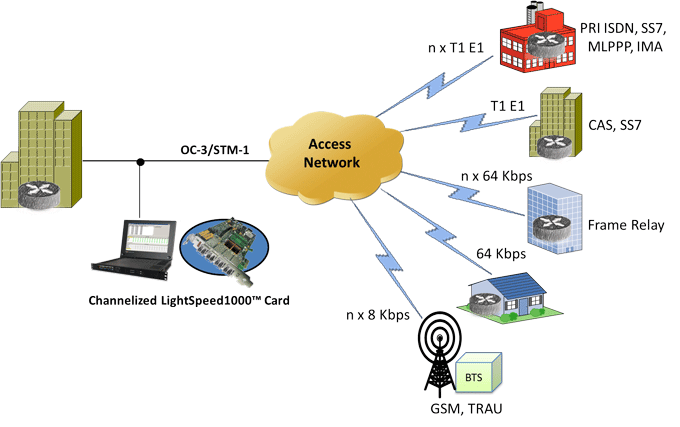Direct T1 E1 Access to SONET SDH Optical Streams for Emulation & Analysis
Gaithersburg, Maryland, USA – November 24, 2014 - GL Communications Inc., announced today the release of its enhanced Optical Channelized Test Platform referred to as LightSpeed1000™.

Speaking to the press, Mr. Jagdish Vadalia, a Senior Manager for product development of the company said, “SONET SDH technology forms the transmission backbone for TDM, IP, and Wireless networks. STM-1 and OC-3 optical transmission rates (155.52 Mbps) are the most common of the various dense pipes (in SDH SONET) carrying E1, T1, E3, T3, and Ethernet multiplexed signals.
The conventional method to access and analyze channelized lines within OC-3 STM-1 can require specific and costly mux/demux hardware. Direct access however, to any channel and traffic type within OC-3 STM-1 would eliminate the need for such costly hardware, simplify testing, monitoring, and analysis.”
He added, “GL's Optical Channelized Test Platform provides such simplicity, permitting direct DS0 level access to hundreds of T1s and E1s, and in the near future all the E3s and T3s constituting the OC-3 and STM-1. This platform with its unique architecture eliminates the requirement for external multiplexing hardware and hundreds of cables and connectors. Multiple, independent streams of any user-defined capacity can be generated internally, analyzed, and monitored in real-time.”
Mr. Vadalia further added, “Enhanced Optical Channelized Test Platform along with accompanying software provides access to thousands of T1s and E1s directly from within an optical SONET or SDH structure. And it has been enhanced to support additional T1 E1 applications as well.”
Important Features
- 2 Channelized OC-3 STM-1 SONET/SDH interfaces per Lightspeed1000™ card – for monitoring both directions
- 2 Unchannelized OC-3 STM-1 OC-12 STM-4 interfaces per Lightspeed1000™ card – for monitoring both directions
- Channelized ports act as terminal multiplexers and demultiplexers
- Supports any combination of DS0/64/56/16/8 kbps fractional T1 E1, and N x T1 E1 interface definitions (a total of 126 E1s or 168 T1s – each port supporting 84 T1s or 63 E1s),
- Pluggable SFPs allow Single-mode (SM), and Multi-mode (MM) fiber optic non-intrusive tap
- API for Microsoft® Windows® and Linux operating Systems to develop user specific applications and more
- Key T1 E1 specific features –
- Comprehensive protocol analysis and emulation – HDLC, SS7, ISDN, CAS, PPP, Frame Relay, ATM and more
- Analysis of DS0s for frequency, power level, spectral display, listen to channel
- GL’s proven WCS high level remote interface
- All protocols analyzers can be used with GL’s NetSurveyorWeb™
Supported SONET Mappings
- STS-3/OC-3 --> STS-1 --> VT-Group --> VT2 --> E1
- STS-3/OC-3 --> STS-1 --> VT-Group --> VT1.5 --> T1
Supported SDH Mappings–
- STM-1 --> AU-3 --> TUG-2 --> TU-12 --> E1
- STM-1 --> AU-4 --> TUG-3 --> TUG-2 --> TU-12 --> E1
- STM-1 --> AU-3 --> TUG-2 --> TU-11 --> T1
- STM-1 --> AU-4 --> TUG-3 --> TUG-2 --> TU-11 --> T1
Supported Applications:
- MAPS™ GSM simulation over A Interface simulates BSSMAP & DTAP messages and signaling specification as defined by 3GPP standards
- MAPS™ SS7 simulation over TDM (T1 E1) simulates Service Switching Point (SSP). The ISUP signaling specification conforms to ITU-T and ANSI standards
- Monitoring GSM Abis link over channelized OC-3 STM-1 for monitoring RF information, Roaming, SMS, Location update, and more
- Testing voice and data services on hybrid networks (such as ATM to SDH)
- Non-intrusive protocol analysis and monitoring (ex: Monitor tens to hundreds of SS7 links for signaling and bearer channels)
 Back to Press Releases Index Page
Back to Press Releases Index Page